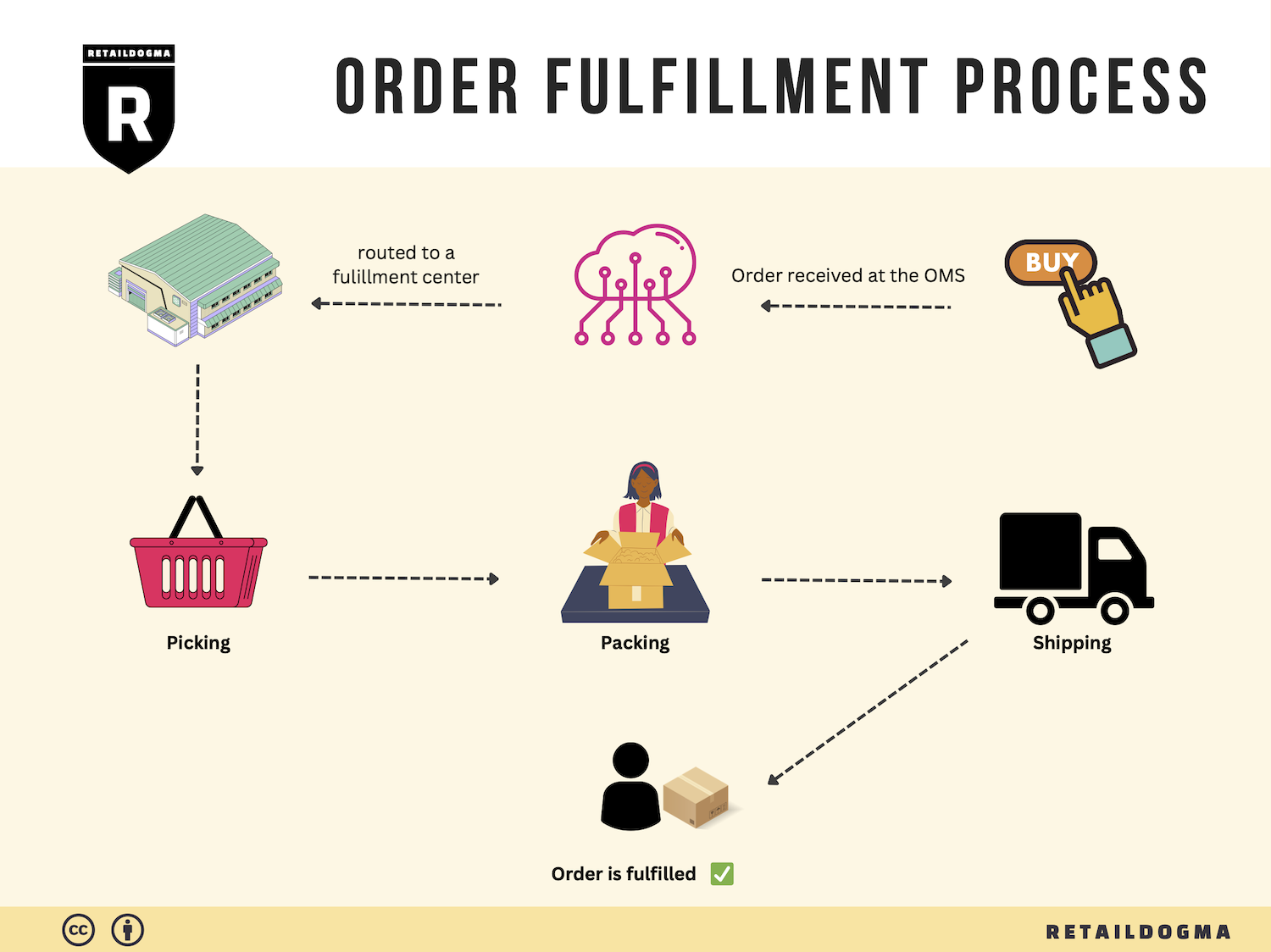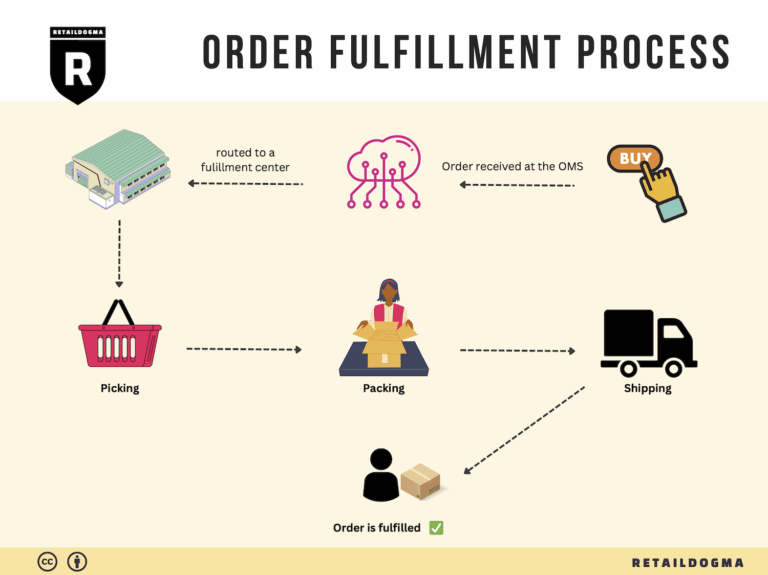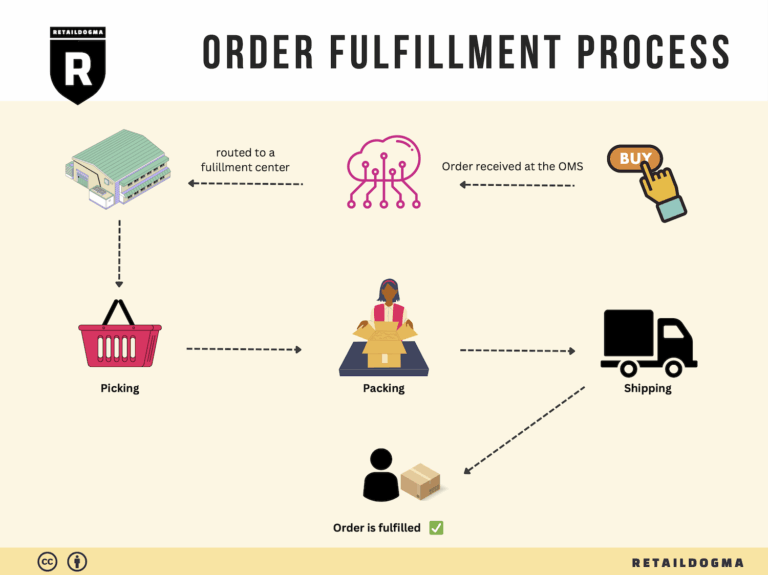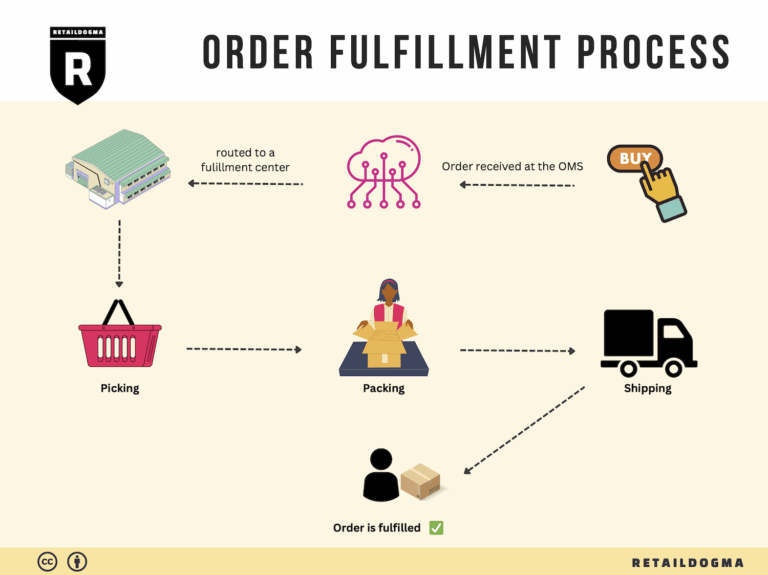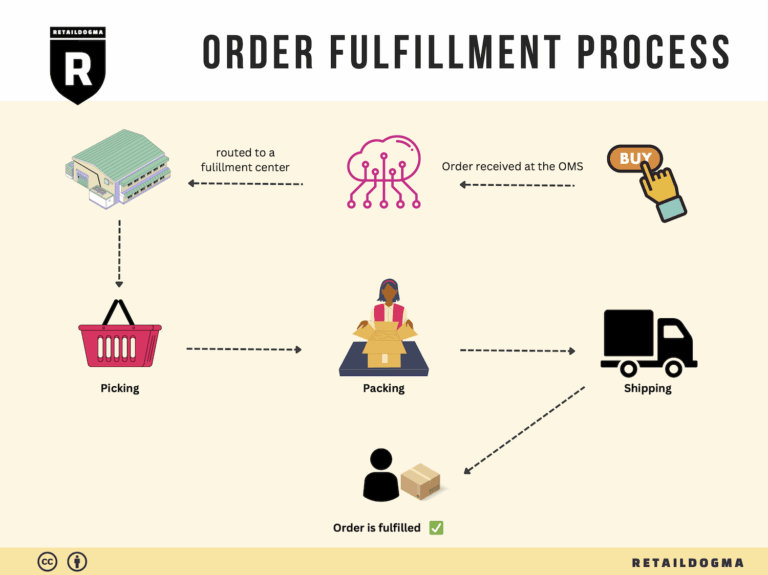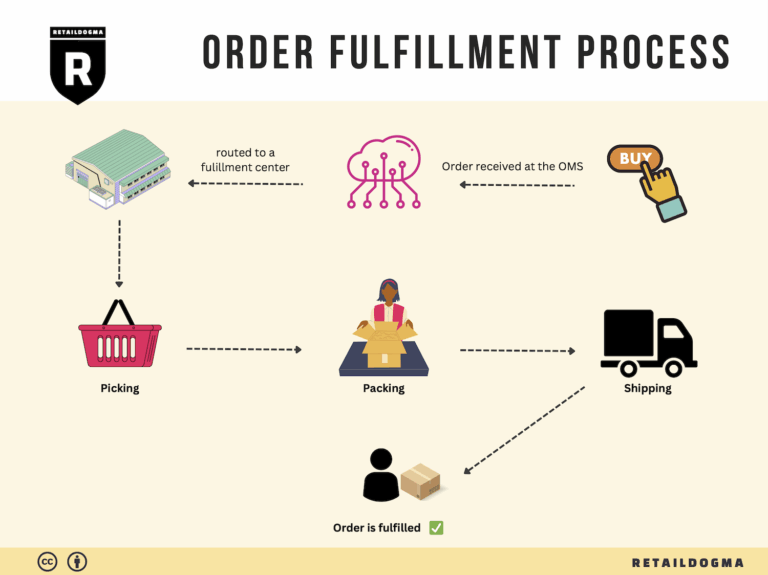How Order Fulfillment Works: A Step-by-Step Guide for Businesses
What is E-commerce Fulfillment? An Introduction for Growing Businesses
Understanding E-commerce Fulfillment
As an e-commerce business owner, you’ve likely faced the daunting task of packing and shipping orders, often feeling overwhelmed by the logistics of getting products to your customers. It’s a common pain point that can stifle growth and distract you from focusing on what matters most—growing your brand and serving your customers. This is where e-commerce fulfillment comes into play.
E-commerce fulfillment can be defined simply as the process of getting a product from your warehouse to your customer’s doorstep. This process encompasses various critical steps, including inventory management, order processing, picking, packing, shipping, and returns handling. As your business scales, managing these operations in-house may become increasingly complex and resource-intensive, leading many entrepreneurs to seek external partners.
In this guide, we will explore the various fulfillment models available to growing businesses, such as Third-Party Logistics (3PL) and Fulfillment by Amazon (FBA). Each model has its own set of advantages and challenges, and understanding these can help you choose the best fit for your business.
We will delve into the core services offered by fulfillment partners, including storage, order processing, and shipping options, as well as value-added services like kitting, labeling, and returns management. Knowing what services are available can aid in streamlining your operations and enhancing your customer experience.
Choosing the right fulfillment partner is crucial to your business’s success. We’ll provide insights into the key factors to consider when selecting a partner, such as their location, technology integration, scalability, and customer service.
Finally, we’ll discuss pricing structures for fulfillment services, helping you understand the costs involved and how to budget for them effectively. By demystifying these aspects of e-commerce fulfillment, we aim to empower you to make informed decisions that will enhance your logistics strategy.
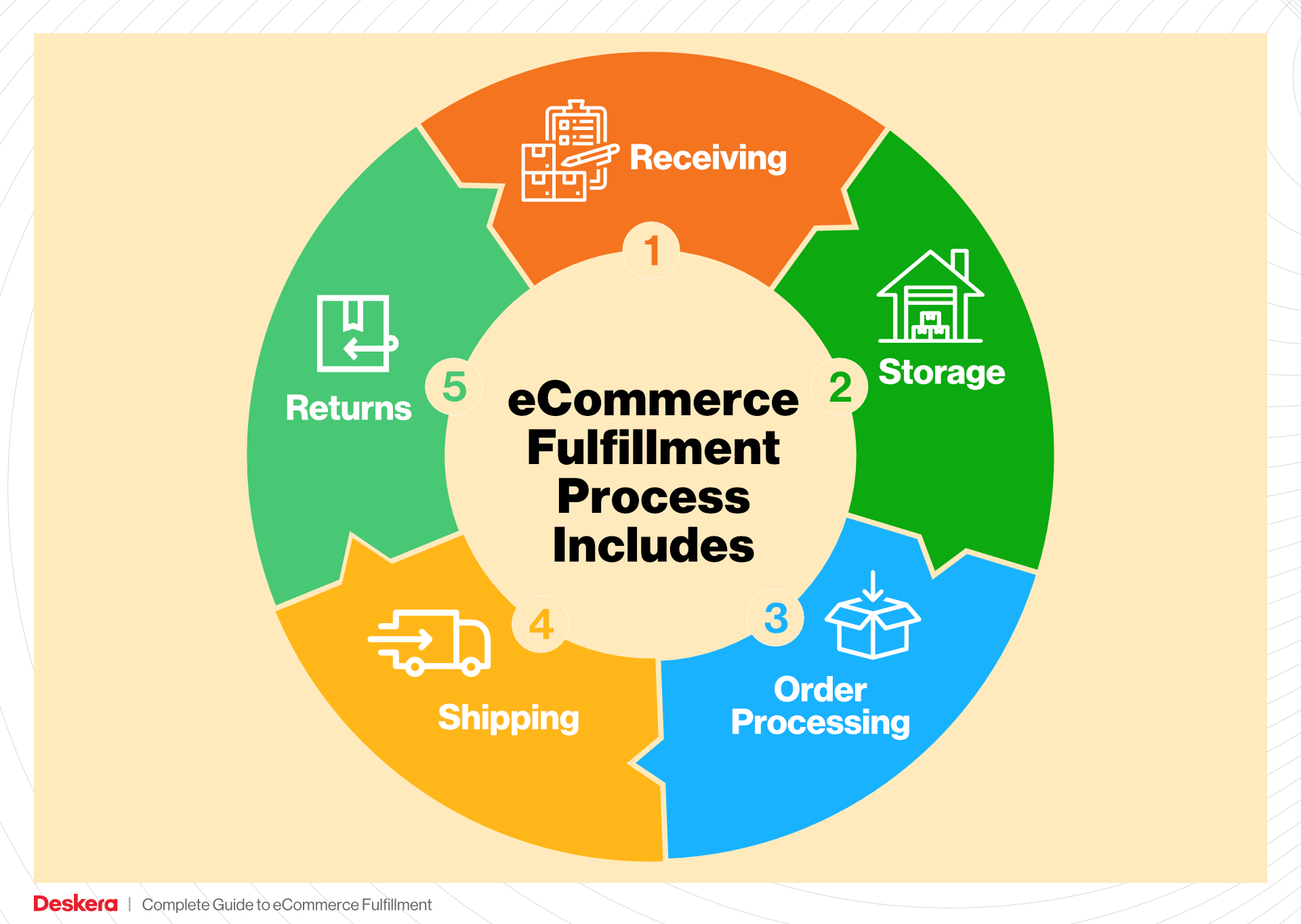
The goal of this guide is to equip you with the knowledge and tools necessary to navigate the complexities of e-commerce fulfillment confidently. As you explore these options, you’ll be better positioned to streamline your operations, reduce overhead costs, and ultimately provide a superior experience for your customers.
What You’ll Learn In This Guide
- What is E-commerce Fulfillment? An Introduction for Growing Businesses
- The Order Fulfillment Process: From ‘Buy’ Button to Customer’s Door
- Comparing Fulfillment Models: In-House vs. 3PL vs. Dropshipping
- A Deep Dive into Amazon FBA: Pros, Cons, and Who It’s For
- Core Services Offered by Fulfillment Centers
- How to Choose a Fulfillment Partner: A 6-Point Checklist
- Understanding Fulfillment Pricing: A Breakdown of Common Fees
- Frequently Asked Questions (FAQs) about Fulfillment
- Conclusion: Is Outsourcing Fulfillment the Right Move for Your Business?
- Important Disclaimer
The Order Fulfillment Process: From ‘Buy’ Button to Customer’s Door
1. Receiving Inventory
The first step in the order fulfillment process is receiving inventory at the fulfillment center. This involves accepting shipments of products from suppliers or manufacturers. Upon arrival, each item is checked for accuracy against the purchase order to ensure that the correct products and quantities have been received.
Importance: This step is crucial for maintaining accurate inventory levels, preventing stock discrepancies, and ensuring that customers receive the correct products. If errors occur at this stage, they can propagate through the fulfillment process, leading to delays and customer dissatisfaction.
Key Term: SKU (Stock Keeping Unit) – Each product is assigned a unique SKU, which helps in tracking inventory levels and managing stock efficiently.
2. Warehouse Storage
Once the inventory is received, the next step is warehouse storage. Products are categorized and stored in designated locations within the fulfillment center. This organization may be based on various factors, such as product type, size, or sales velocity.
Importance: Effective warehouse storage is vital for optimizing space and ensuring quick access to products. Properly organized inventory reduces the time spent locating items during the picking process, ultimately speeding up order fulfillment and increasing operational efficiency.
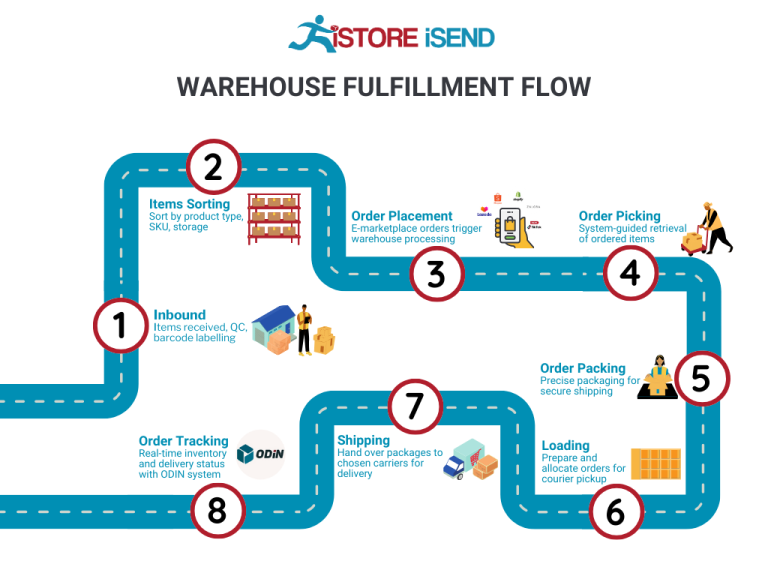
Key Term: Bin Location – Each product is assigned a specific bin location, which facilitates easy retrieval during the picking process.
3. Order Picking
When a customer places an order, the next step is order picking. Warehouse staff use order pick lists—documents that detail which items need to be collected for a specific order. This process may involve manual picking or the use of technology such as mobile devices or automated systems to streamline operations.
Importance: Order picking is a critical step as it directly impacts order accuracy and fulfillment speed. Errors during picking can lead to incorrect shipments, resulting in returns and customer dissatisfaction. Efficient picking processes also contribute to better overall productivity.
Key Term: Pick List – This document outlines the items to be picked for each order, including quantities and locations, ensuring that the right products are collected.
4. Order Packing
After items are picked, they move to the packing station. Here, products are carefully packed into boxes or envelopes, along with any necessary documentation, such as packing slips or return instructions. This step often includes quality checks to ensure that the correct items are packed and that they are adequately protected for shipping.
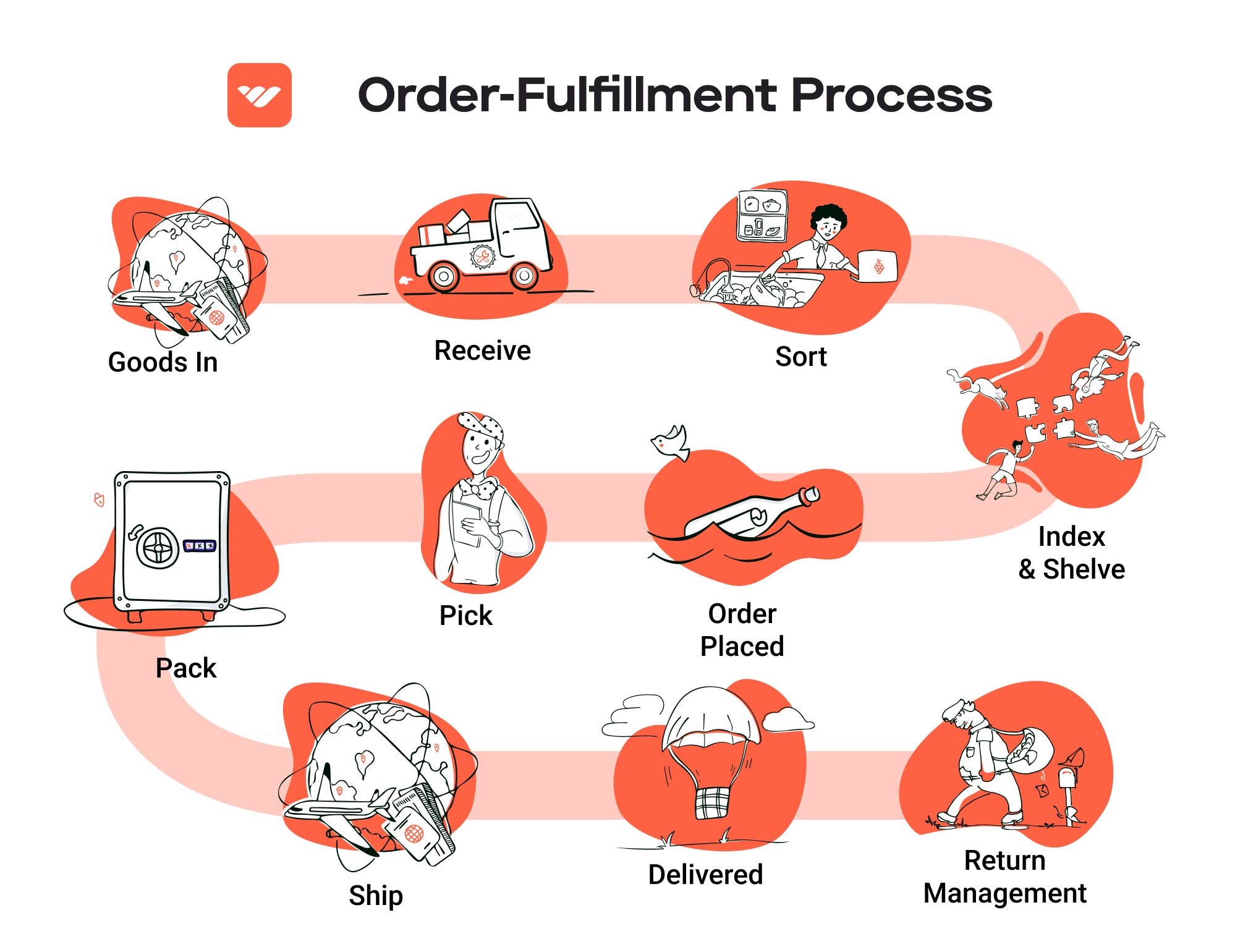
Importance: Proper packing is essential to prevent damage during transit and to enhance the unboxing experience for customers. Additionally, well-packed orders can reduce shipping costs and minimize returns due to damaged goods.
Key Term: Packing Slip – A document included in the package that lists the items included in the shipment, helping both the customer and the fulfillment team confirm order accuracy.
5. Shipping & Delivery
The final step in the order fulfillment process is shipping and delivery. Once packed, orders are labeled and prepared for shipment. This involves selecting the appropriate shipping method based on factors such as cost, speed, and destination. Fulfillment centers often partner with various carriers to offer customers multiple shipping options.
Importance: Timely and accurate shipping is vital for customer satisfaction. Customers expect their orders to arrive quickly and in good condition. Efficient shipping processes also impact the business’s bottom line, as they can influence shipping costs and delivery times.
Key Term: Carrier – The shipping company responsible for transporting the package from the fulfillment center to the customer’s address. Choosing the right carrier can optimize costs and delivery speed.
By understanding and optimizing each step of the order fulfillment process, e-commerce businesses can enhance operational efficiency, improve customer satisfaction, and scale their logistics effectively. Each step, from receiving inventory to final delivery, plays a crucial role in ensuring that customers receive their orders accurately and on time.
Comparing Fulfillment Models: In-House vs. 3PL vs. Dropshipping
Fulfillment Model Comparison Table
| Model | Who Handles Inventory | Best For (Business Stage) | Key Advantage | Key Disadvantage |
|---|---|---|---|---|
| In-House Fulfillment | Your own team | Established businesses | Complete control over operations | High overhead costs |
| Third-Party Logistics (3PL) | 3PL provider | Growing businesses | Scalability and reduced operational burden | Less control over inventory management |
| Dropshipping | Supplier/vendor | Startups and small businesses | Low startup costs | Lower profit margins and longer shipping times |
In-House Fulfillment
In-house fulfillment refers to a model where a business manages its own inventory and order processing using its own resources. This typically involves having a dedicated warehouse or storage space, staff for picking and packing orders, and logistics capabilities to handle shipping. This model is best suited for established businesses that have already achieved a stable level of sales and have the financial resources to invest in infrastructure.
The primary advantage of in-house fulfillment is the complete control it offers. Businesses can manage their inventory more effectively, ensuring that stock levels are optimized to meet customer demand. This control extends to quality assurance, as businesses can directly oversee the packing and shipping process. However, the downside is significant overhead costs associated with maintaining a warehouse, hiring staff, and investing in inventory management systems. Moreover, as businesses grow, scaling operations can become complex and resource-intensive, requiring careful planning and execution.
Third-Party Logistics (3PL)
Third-party logistics (3PL) involves outsourcing warehousing and fulfillment services to a third-party provider. In this model, businesses partner with logistics firms that specialize in storage, inventory management, and shipping. This approach is particularly beneficial for growing businesses that need to scale quickly without the burden of managing logistics themselves.
One of the key advantages of using a 3PL is scalability. As demand fluctuates, businesses can easily adjust their logistics needs without significant investment in infrastructure. 3PL providers often have established networks that can expedite shipping and reduce costs, allowing businesses to focus on core operations such as marketing and sales. However, this model does come with a trade-off: businesses relinquish some control over their inventory management. This can lead to challenges in maintaining visibility over stock levels and ensuring that the quality of fulfillment meets customer expectations. Additionally, reliance on a third party can result in complications if the provider fails to meet service levels.
Dropshipping
Dropshipping is a fulfillment method where businesses sell products without holding inventory. Instead, when a customer makes a purchase, the order is forwarded to a supplier who then ships the product directly to the customer. This model is particularly popular among startups and small businesses that want to minimize upfront investment and risk.
The most significant advantage of dropshipping is the low barrier to entry. Entrepreneurs can launch e-commerce stores without the need for significant capital investment in inventory or warehousing. This allows for a wide variety of products to be offered without the burden of managing stock. However, dropshipping also presents challenges, including lower profit margins since suppliers typically charge a premium for their services. Furthermore, shipping times can be longer, as orders are shipped directly from suppliers, which can impact customer satisfaction. Additionally, businesses have limited control over inventory and quality, making it crucial to partner with reliable suppliers to ensure a consistent customer experience.
Conclusion
Choosing the right fulfillment model depends on various factors, including the stage of your business, available resources, and strategic goals. In-house fulfillment offers control and quality but comes with higher costs and complexity. Third-party logistics provide scalability and reduced operational burdens, while dropshipping allows for low startup costs but may lead to lower profit margins and longer shipping times. Each model has its strengths and weaknesses, and understanding these can help e-commerce business owners make informed decisions that align with their growth strategies.
A Deep Dive into Amazon FBA: Pros, Cons, and Who It’s For
Understanding Fulfillment by Amazon (FBA)
Fulfillment by Amazon (FBA) is a service that allows e-commerce sellers to store their products in Amazon’s fulfillment centers. Amazon takes care of storage, packaging, and shipping of these products to customers, along with handling returns and customer service inquiries. This service allows sellers to leverage Amazon’s extensive logistics network and customer trust, making it an appealing option for many e-commerce businesses.
How FBA Works
-
Setting Up FBA: To start using FBA, sellers need to create an Amazon seller account and enroll in the FBA program. Once enrolled, sellers can create product listings and prepare their inventory for shipment to Amazon’s fulfillment centers.
-
Inventory Shipment: Sellers send their products to designated Amazon fulfillment centers. Amazon provides guidelines on how to package and label products to ensure they are received correctly.
-
Storage and Fulfillment: Once the inventory arrives at Amazon, it is stored in the fulfillment center until an order is placed. When a customer places an order, Amazon picks, packs, and ships the product directly to the customer.
-
Customer Service and Returns: Amazon also manages customer service inquiries and handles returns for FBA orders, allowing sellers to focus on other aspects of their business.
-
Sales Channels: FBA can be utilized not just on Amazon’s marketplace but also for sales made on other platforms, allowing sellers to fulfill orders from multiple channels through the same Amazon logistics network.
Pros of Fulfillment by Amazon (FBA)
-
Prime Eligibility: Products fulfilled through FBA are eligible for Amazon Prime, which can significantly increase visibility and sales. Prime members often prefer products with Prime shipping due to the fast delivery times.
-
Customer Trust: Leveraging Amazon’s trusted brand can enhance consumer confidence in purchases. Customers are more likely to buy from sellers using FBA, knowing that Amazon will handle their order professionally.
-
Multi-Channel Fulfillment: FBA allows sellers to fulfill orders from various sales channels beyond Amazon, such as eBay or their own websites. This capability can streamline logistics and improve overall efficiency.
-
Scalability: FBA provides the infrastructure needed to scale without having to invest heavily in logistics and warehousing. Sellers can focus on marketing and product development while Amazon manages storage and shipping.
-
Automation of Logistics: By outsourcing logistics to Amazon, sellers can save time and resources. Amazon automates storage, shipping, and customer service, which can lead to improved operational efficiency.
-
Handling Returns: Amazon takes care of product returns, which can be a complex and resource-intensive process for e-commerce sellers. This alleviates a significant burden from sellers, allowing them to focus on growing their business.
Cons of Fulfillment by Amazon (FBA)
-
High Fees: FBA comes with various fees, including storage fees and fulfillment fees. These can add up quickly, especially for sellers with low-margin products or those with slow-moving inventory. It is essential for sellers to understand their cost structure to maintain profitability.
-
Strict Inventory Management Rules: Amazon has strict guidelines regarding inventory management, including how to label and package products. Sellers must ensure compliance with these rules to avoid penalties or inventory being returned or destroyed.
-
Commingling Risks: Amazon’s FBA program allows for commingled inventory, meaning that sellers’ products may be mixed with those of other sellers. This can pose risks, such as receiving returns for items that were not originally sold by the seller, leading to potential disputes and customer dissatisfaction.
-
Less Control Over Fulfillment: By outsourcing fulfillment to Amazon, sellers relinquish some control over the shipping process. This includes aspects such as packaging and shipping speed, which may not always align with the seller’s brand image.
-
Inconsistent Customer Experience: While Amazon generally provides a high level of customer service, there can be inconsistencies in how returns and customer inquiries are handled. This could affect the seller’s reputation if issues arise.
-
Inventory Storage Limitations: During peak seasons, Amazon may impose limits on the amount of inventory a seller can store in their fulfillment centers, which can hinder a seller’s ability to meet demand.
Who is FBA Best For?
FBA is particularly beneficial for:
-
Small to Medium-Sized Businesses: Businesses looking to scale operations without investing heavily in logistics can find FBA to be a practical solution. It allows them to focus on product development and marketing.
-
Sellers with High-Volume Sales: If a seller has a high turnover rate for products, the benefits of FBA can outweigh the costs, making it an efficient fulfillment option.
-
New Entrepreneurs: Those just starting in e-commerce can leverage FBA to enter the market quickly, using Amazon’s established infrastructure to handle logistics.
-
Multi-Channel Sellers: Businesses selling on multiple platforms can streamline their fulfillment processes through FBA, ensuring consistent delivery and customer service across all sales channels.
-
Seasonal Sellers: Companies that experience seasonal spikes in sales can benefit from FBA’s ability to handle large volumes of orders without requiring long-term commitments to warehousing.
In summary, Fulfillment by Amazon (FBA) can be a powerful tool for e-commerce sellers looking to scale their business. While it comes with its own set of challenges, the advantages—such as increased visibility, customer trust, and streamlined logistics—often outweigh the drawbacks for many sellers. Understanding these dynamics is essential for making an informed decision about whether FBA is the right fit for your business.
Core Services Offered by Fulfillment Centers
Inventory Management & Warehousing
Inventory management and warehousing are the foundational services offered by fulfillment centers. These facilities provide businesses with dedicated storage space for their products, allowing for efficient inventory control and organization. Fulfillment centers utilize advanced inventory management systems that track stock levels in real-time, ensuring that businesses always know what products are available and when to reorder.
The benefits of efficient inventory management are manifold. Firstly, it minimizes the risk of overstocking or stockouts, which can lead to lost sales and increased carrying costs. With accurate data on inventory levels, businesses can optimize their purchasing strategies, reducing waste and enhancing cash flow. Additionally, fulfillment centers often employ strategies like FIFO (First In, First Out) to ensure that older inventory is sold before newer stock, further optimizing product turnover. This service allows e-commerce businesses to focus on growth and sales, rather than the complexities of inventory logistics.
Pick and Pack Services
Pick and pack services are critical to the fulfillment process. This service involves selecting (picking) the ordered products from the warehouse and packaging (packing) them appropriately for shipment. Fulfillment centers employ skilled staff and automated systems to ensure that orders are picked accurately and efficiently. The packing process often includes quality checks, ensuring that the correct items are shipped in excellent condition.
The benefits of pick and pack services are significant for e-commerce businesses. Efficient picking reduces the time it takes to fulfill orders, which translates to faster delivery times—a critical factor in customer satisfaction. Additionally, proper packing minimizes damage during transit, leading to fewer returns and increased customer trust. By outsourcing this process to a fulfillment center, businesses can scale their operations without the need for additional staffing or training, allowing them to focus on strategic growth initiatives.
Kitting and Assembly
Kitting and assembly is a specialized service that involves combining multiple products into a single package or kit before shipping. This can include bundling items for promotional sales, assembling products that require multiple components, or creating customized kits for specific customer needs. Fulfillment centers are equipped to handle these tasks, often using dedicated staff and equipment to ensure precision and efficiency.
The value of kitting and assembly services lies in their ability to enhance product offerings and improve customer satisfaction. By providing bundled products or customized kits, businesses can create unique value propositions that differentiate them from competitors. Furthermore, this service streamlines the order fulfillment process, as customers receive all necessary components in one shipment, reducing the likelihood of partial orders and improving overall customer experience. For businesses looking to innovate and offer tailored solutions, kitting and assembly services can be a game-changer.
Returns Management (Reverse Logistics)
Returns management, often referred to as reverse logistics, is a critical service offered by fulfillment centers. This process involves handling the return of products from customers back to the warehouse, including inspection, restocking, and processing refunds or exchanges. Fulfillment centers implement robust returns management systems to streamline this process, ensuring that returns are handled efficiently and accurately.
The benefits of effective returns management are substantial for e-commerce businesses. A streamlined returns process enhances customer satisfaction, as easy returns can lead to higher customer loyalty and repeat purchases. Additionally, efficient reverse logistics can help businesses recover value from returned items, whether through restocking, refurbishing, or reselling. By outsourcing returns management to a fulfillment center, businesses can reduce operational burdens, minimize costs associated with returns, and maintain a positive brand image in the eyes of consumers. This service is especially vital in today’s e-commerce environment, where customers expect hassle-free returns as part of their shopping experience.
Conclusion
In summary, fulfillment centers offer a suite of essential services that can significantly enhance the operational efficiency of e-commerce businesses. By leveraging inventory management and warehousing, pick and pack services, kitting and assembly, and returns management, businesses can streamline their logistics processes, improve customer satisfaction, and ultimately drive growth. As e-commerce continues to evolve, partnering with a capable fulfillment center can provide a competitive edge that is crucial for success.
How to Choose a Fulfillment Partner: A 6-Point Checklist
Location & Warehouse Network
Why It’s Important:
The geographic location of your fulfillment partner’s warehouses directly impacts shipping times and costs. A partner with warehouses strategically placed near your customer base can enhance delivery speed and reduce transportation expenses.
Questions to Ask:
– Where are your warehouses located, and how do they align with my customer demographics?
– Can you provide details on your shipping times for various regions?
– How do you manage inventory across multiple locations, and what is your process for optimizing stock levels?
Technology & Integrations
Why It’s Important:
In today’s digital landscape, seamless integration with your existing e-commerce platforms, such as Amazon, Shopify, or WooCommerce, is crucial. Advanced technology ensures real-time inventory tracking, order processing, and data analytics, which can significantly enhance operational efficiency.
Questions to Ask:
– What systems and software do you use for inventory management and order fulfillment?
– Are you compatible with my current e-commerce platforms? Can you demonstrate this integration?
– How do you handle data security and privacy, especially regarding customer information?
Specializations (e.g., cold storage, oversized items)
Why It’s Important:
Depending on your product types, you may require specific storage solutions. If you sell perishable items, for instance, partnering with a provider that has cold storage facilities is essential. Similarly, if you deal with oversized or fragile items, ensure the partner has the necessary capabilities.
Questions to Ask:
– What types of products do you specialize in handling?
– Do you have specific facilities for cold storage or hazardous materials?
– How do you manage the handling and storage of oversized or fragile items?
Scalability & Capacity
Why It’s Important:
As your business grows, your fulfillment needs will change. A partner that can scale its operations to accommodate increased demand is vital to avoid disruptions in service and ensure customer satisfaction.
Questions to Ask:
– How do you handle peak seasons or sudden spikes in order volume?
– Can you provide case studies or examples of how you have scaled for other clients?
– What is your capacity for storage and fulfillment, and how quickly can you expand if needed?
Pricing and Contracts
Why It’s Important:
Understanding the pricing structure and contract terms is critical to maintaining a healthy profit margin. Transparency in pricing can help you avoid unexpected costs that can arise from hidden fees or unfavorable contract terms.
Questions to Ask:
– What is your pricing model (e.g., per order, per item, storage fees)?
– Are there any additional fees I should be aware of, such as for returns, packaging, or special handling?
– What are the terms for contract termination, and is there flexibility in the contract duration?
Customer Support & Reviews
Why It’s Important:
Reliable customer support is essential for resolving issues promptly and maintaining smooth operations. Additionally, checking reviews and testimonials can provide insights into the partner’s reliability and customer satisfaction levels.
Questions to Ask:
– What customer support channels do you offer (e.g., phone, email, chat), and what are your response times?
– Can you provide references from current or past clients?
– How do you handle issues or disputes that may arise during the fulfillment process?
By following this checklist, e-commerce business owners, operations managers, and entrepreneurs can make informed decisions when selecting a fulfillment partner. The right partner will not only streamline logistics but also enhance overall customer satisfaction, which is crucial for scaling your business successfully.
Understanding Fulfillment Pricing: A Breakdown of Common Fees
Initial Setup Fees
Initial setup fees are typically charged when a business first enrolls in a fulfillment service. This fee covers the administrative costs associated with onboarding a new client, including account setup, software integration, and any necessary training. While the specifics can vary significantly by provider, these fees generally range from $50 to $500 depending on the complexity of the services required and the scale of the business.
Businesses can expect to pay this fee once, but it’s essential to clarify whether it includes ongoing support or if there are additional costs for future adjustments. New sellers should also inquire about potential discounts or waivers, especially if they commit to a longer-term contract.
Receiving Fees
Receiving fees are incurred when inventory is delivered to the fulfillment center. This fee covers the labor and administrative costs associated with unloading, inspecting, and storing the incoming products. The cost is usually calculated per pallet or per unit, with typical charges ranging from $15 to $30 per pallet or $0.50 to $1.00 per item.
To manage these costs effectively, e-commerce businesses should ensure that shipments are well-packaged and labeled correctly to avoid additional handling fees. Additionally, scheduling deliveries during off-peak hours may help reduce wait times and associated costs.
Storage Fees (per pallet/bin)
Storage fees are charged for the space that inventory occupies within the fulfillment center. This fee is typically calculated on a monthly basis and can vary based on the size of the inventory. Businesses may encounter a cost of approximately $10 to $25 per pallet per month, or $0.50 to $2.00 per bin.
It’s crucial to monitor inventory levels closely to avoid overstocking, which can lead to increased storage costs. Some fulfillment centers also impose long-term storage fees for items that remain unsold for extended periods, so businesses should have a clear inventory turnover strategy in place.
Pick & Pack Fees (per item/order)
Pick and pack fees are charged for the labor involved in retrieving items from storage and preparing them for shipment. These fees can be calculated per item or per order, with costs typically ranging from $1.00 to $3.00 per item or $2.00 to $5.00 per order.
The variation in fees often depends on the complexity of the orders; for example, multi-item orders may incur higher fees due to the additional labor involved. To optimize these costs, businesses should consider consolidating orders or packaging products efficiently to minimize the number of picks required.
Shipping Fees
Shipping fees cover the cost of transporting the packaged products to the customer. These fees can vary widely based on the shipping method, destination, and weight of the package. E-commerce businesses typically have the option of choosing standard, expedited, or same-day shipping, with costs that can range from $5.00 for standard shipping to $50.00 or more for expedited services.
To effectively manage shipping costs, businesses should negotiate rates with carriers and explore options like flat-rate shipping or incorporating shipping costs into product pricing. Additionally, leveraging fulfillment centers with strategic locations can help reduce shipping distances and costs.
Tips for Getting an Accurate Quote
-
Provide Detailed Information: When requesting quotes, provide detailed information about your product dimensions, weights, and expected order volumes. This information is critical for accurate pricing.
-
Ask About Hidden Fees: Inquire about any additional fees that may not be included in the initial quote, such as long-term storage fees or charges for returns.
-
Consider Seasonal Variations: Some fulfillment centers may have different pricing structures during peak seasons. Ensure that your quote reflects your expected shipping volume throughout the year.
-
Negotiate Terms: Don’t hesitate to negotiate terms and pricing based on your projected volume. Many fulfillment centers offer discounts for higher volumes or long-term contracts.
-
Evaluate Service Levels: Finally, assess the level of service included in the quote. A slightly higher fee might be justified if it includes better customer support, faster shipping times, or more flexible storage options.
By understanding these common fulfillment fees and their calculations, e-commerce businesses can make informed decisions that align with their growth strategies and budget constraints.
Frequently Asked Questions (FAQs) about Fulfillment
1. What is Amazon Fulfillment Center MDT4?
MDT4 is one of Amazon’s many fulfillment centers, located in the Carlisle, Pennsylvania area. It serves as a hub for storing, picking, packing, and shipping products sold by third-party sellers using Amazon’s Fulfillment by Amazon (FBA) service. This center helps streamline the logistics process, ensuring quick delivery to customers across the United States.
2. How does the fulfillment process work at MDT4?
The fulfillment process at MDT4 involves several steps:
1. Receiving: Products are received and checked into the inventory system.
2. Storage: Items are stored in designated areas within the fulfillment center.
3. Order Processing: When an order is placed, the system identifies the location of the items.
4. Picking: Warehouse associates retrieve the items from storage.
5. Packing: The picked items are packed securely for shipment.
6. Shipping: Packed orders are sent to the shipping carriers for delivery to customers.
3. What is the difference between a warehouse and a fulfillment center?
A warehouse primarily focuses on storage, whereas a fulfillment center integrates storage with order processing, packing, and shipping. Fulfillment centers are designed to handle the logistics of e-commerce, providing services that enable quicker order delivery and enhanced customer satisfaction.
4. What is a 3PL?
A 3PL, or Third-Party Logistics provider, is a company that offers outsourced logistics services, including transportation, warehousing, and fulfillment. Businesses often partner with 3PLs to manage their supply chain operations more efficiently, allowing them to focus on core business activities while leveraging the expertise of logistics specialists.
5. How much do fulfillment services cost?
Fulfillment service costs can vary widely based on factors such as storage fees, order processing fees, and shipping costs. On average, businesses might expect to pay between $2 to $5 per order for fulfillment services, in addition to storage fees that can range from $0.50 to $2 per cubic foot per month, depending on the provider and specific services offered.
6. Can I use MDT4 for my own e-commerce business?
Yes, as an Amazon seller using the FBA program, you can store your products at MDT4. When customers order your products on Amazon, the fulfillment center will handle the logistics, ensuring timely delivery. This allows you to leverage Amazon’s infrastructure to scale your business without managing your own warehousing and shipping.
7. What types of products can be stored at MDT4?
MDT4 can accommodate a wide range of products, from electronics and clothing to household goods and books. However, certain restrictions apply to hazardous materials and perishable items. It’s essential to review Amazon’s guidelines to ensure your products comply with their storage regulations.
8. How does Amazon ensure the quality of fulfillment at MDT4?
Amazon employs various quality control measures at its fulfillment centers, including regular training for staff, technology-driven inventory management systems, and automated packing processes. This helps minimize errors and ensures that products are picked, packed, and shipped accurately.
9. How do I track my inventory at MDT4?
Sellers can track their inventory through the Amazon Seller Central dashboard. This platform provides real-time updates on inventory levels, sales performance, and fulfillment status. It allows sellers to manage their stock effectively and make informed decisions regarding restocking and order fulfillment.
10. What are the benefits of using MDT4 for fulfillment?
Utilizing MDT4 for fulfillment offers several advantages:
– Fast Shipping: Benefit from Amazon’s logistics network for quicker delivery times.
– Scalability: Easily scale your operations to meet growing demand without the overhead of managing a warehouse.
– Customer Trust: Leverage Amazon’s reputation for reliability to enhance customer trust and satisfaction.
– Comprehensive Support: Access to Amazon’s support resources and tools to optimize your selling strategy.
Conclusion: Is Outsourcing Fulfillment the Right Move for Your Business?
Assessing the Benefits of Outsourcing Fulfillment
Outsourcing your fulfillment can be a transformative decision for your e-commerce business, offering several key advantages that can significantly impact your operations. One of the most compelling benefits is time savings. By delegating logistics to a fulfillment partner, you free up valuable time that can be redirected toward growth strategies, product development, and customer engagement—areas that directly contribute to your bottom line.
Scalability is another critical advantage. As your business grows, so do the complexities of managing inventory, shipping, and customer service. A robust fulfillment service can seamlessly scale with your demands, whether you’re experiencing a seasonal spike or launching a new product line. This flexibility allows you to respond swiftly to market changes without the burden of overextending your internal resources.
Moreover, expertise plays a pivotal role in successful fulfillment. Many fulfillment partners bring specialized knowledge and experience that can optimize your shipping processes, minimize costs, and enhance customer satisfaction. Their established networks and technology can provide efficiencies that might be challenging to achieve independently, especially for smaller businesses.
However, it’s essential to choose the right fulfillment partner to truly harness these benefits. Conducting due diligence on potential partners is crucial—look for those with a proven track record, excellent customer service, and capabilities that align with your business goals.
Take Action
Now is the time to assess your current shipping and fulfillment processes. Conduct an audit to identify pain points and inefficiencies. Ask yourself if partnering with a fulfillment service could enhance your operational efficiency and support your growth ambitions. By making informed decisions today, you can position your business for sustainable success in the competitive e-commerce landscape.
Important Disclaimer
⚠️ Important Disclaimer
The information in this guide is for educational purposes. Fulfillment services, pricing, and platform features change frequently. Always conduct your own due diligence and consult with providers directly before making business decisions.
